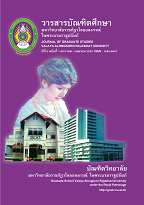กลยุทธ์การตลาดภายในสำหรับการส่งเสริมความจงรักภักดี และการธำรงรักษานักบินในธุรกิจการขนส่งทางอากาศระหว่างประเทศ INTERNAL MARKETING STRATEGY TO ENHANCE EMPLOYEE LOYALTY AND EMPLOYEE RETENTION IN INTERNATIONAL AIR TRANSPORTATION BUSINESS
Main Article Content
Abstract
บทคัดย่อ
การศึกษาวิจัยครั้งนี้ ได้กำหนดวัตถุประสงค์การวิจัย จำนวน 4 ข้อ คือ 1. เพื่อศึกษาแนวทางการบริหาร และจัดการนักบิน ในด้านการคัดเลือก การฝึกอบรม การประเมินผล การจ่ายค่าตอบแทน และการสร้างแรงจูงใจของสายการบินภายในประเทศ 2. เพื่อศึกษากระบวนการตลาดภายในองค์กรเพื่อสร้างความจงรักภักดี และการธำรงรักษานักบินของสายการบินภายในประเทศ3. เพื่อสำรวจทัศนคติของนักบินที่มีต่อกระบวนการบริหารจัดการนักบินในปัจจุบัน 4. เพื่อจัดทำโมเดลต้นแบบและกลยุทธ์การตลาดภายในเพื่อการสร้างความจงรักภักดี และการธำรงรักษานักบิน ในธุรกิจการบินประเทศไทย ในการเข้าสู่ประชาคมอาเซียน โดยใช้เทคนิค การวิจัยทั้ง 2 แบบ คือ การวิจัยเชิงคุณภาพ (Qualitative Research) โดยใช้เทคนิคสโนว์บอล (Snowball Sampling Technique) และ การวิจัยเชิงปริมาณ (Quantitative Research) โดยใช้วิธีการวิจัยเชิงสำรวจ (Survey Research) แบบวัดครั้งเดียว (One-Short Study) กับนักบินของสายการบินภายในประเทศ จำนวน 550 คน ของ สายการบินไทย สายการบินบางกอกแอร์เวย์ สายการบินไทยแอร์เอเชีย สายการบินนกแอร์ และ สายการบินโอเรียนท์ไทย การทดสอบการหาความเที่ยงตรง และคุณภาพของเครื่องมือให้สอดคล้องกับเนื้อหา (Content Validity) และทำการตามเทคนิค Item Objective Congruent (IOC) โดยผู้เชี่ยวชาญที่มีประสบการณ์การบิน จำนวน 8 คน ซึ่งได้ค่า ดัชนีความสอดคล้องกับเนื้อหา ได้ มากกว่า .05 ทุกข้อ และ ค่าเฉลี่ยความเชื่อมั่นของเครื่องมือ การวิจัยได้ (Reliability) ซึ่งได้ค่า Alpha Coefficient เท่ากับ 0.945 ซึ่งอยู่ในระดับที่สูง และมี ความเที่ยงตรงที่อยู่ในเกณฑ์ยอมรับได้
รายงานวิจัยฉบับนี้ ได้ทำการวิเคราะห์ข้อมูล ตามวัตถุประสงค์ จำนวน 4 ข้อ โดยสามารถอธิบายรายละเอียดได้ตามวัตถุประสงค์ คือ วัตถุประสงค์ที่ 1 โดยได้ทำการวิจัยย่อย ซึ่งกำหนดวัตถุประสงค์ในการวิจัยย่อย จำนวน 2 ข้อ คือ 1.1 เพื่อทำการศึกษาสถานการณ์ปัจจุบัน และความสำคัญของธุรกิจบริการด้านการขนส่งทางอากาศระหว่างประเทศ 1.2 เพื่อทำการศึกษาความได้เปรียบเชิงการแข่งขันในการบริการธุรกิจสายการบินระหว่างประเทศ โดยใช้เทคนิคการวิเคราะห์โดยการใช้เครื่องมือตามวัตถุประสงค์ย่อย จำนวน 2 ข้อ คือ 1.1 การใช้แนวคิด ทฤษฎี วรรณกรรม การเข้าร่วมการสัมมนา และ เอกสารประกอบการอบรม สัมมนาเกี่ยวกับเรื่องการมุ่งสู่ประชาคมอาเซียน (ASEAN Community) 1.2 การประยุกต์ใช้ของกลยุทธ์ความได้เปรียบเชิงการแข่งขันในการบริการธุรกิจสายการบินระหว่างประเทศ (Diamond Model) วัตถุประสงค์ที่ 2 โดยใช้เทคนิคการวิเคราะห์โดยสัมภาษณ์ผู้เชี่ยวชาญและนำมาประยุกต์ใช้หลักการวิเคราะห์จากหลักแนวคิดทฤษฎี (7 S) วัตถุประสงค์ที่ 3 โดยใช้เทคนิค โดยการใช้สถิติการวิเคราะห์ คือ ค่าร้อยละ (Percentage) การหาค่าความถี่ (Frequency) การหาค่าเฉลี่ย (Mean) ค่าเบี่ยงเบนมาตรฐาน (Standard Deviation) ตามแต่ละส่วนของเครื่องมือแบบสอบถาม และ วัตถุประสงค์ที่ 4 โดยการกำหนด การวิเคราะห์ แบ่งเป็น 2 ส่วน คือ 4.1 ส่วนการจัดทำโมเดลต้นแบบของกลยุทธ์การตลาดภายใน โดยใช้เทคนิคการวิเคราะห์องค์ประกอบเชิงสำรวจ (Exploratory Factor Analysis: EFA) และ การวิเคราะห์องค์ประกอบเชิงยืนยัน (Confirmatory Factor Analysis: CFA) และ 4.2 จัดทำแนวทางการนำเสนอ กลยุทธ์ที่เหมาะสมของกลยุทธ์การตลาดภายในเพื่อการสร้างความจงรักภักดี และการธำรงรักษานักบิน ในธุรกิจการบินประเทศไทย ในการเข้าสู่ประชาคมอาเซียน
การศึกษาวิจัยครั้งนี้ได้ค้นพบ กลยุทธ์ที่เหมาะสม กับ กลยุทธ์การตลาดภายในสำหรับการส่งเสริมความจงรักภักดี และ การธำรงรักษานักบินในธุรกิจการขนส่งทางอากาศระหว่างประเทศ และสามารถนำเสนอกลยุทธ์ คือ กลยุทธ์ พาร์ (PAR Strategy) ส่วนของกลุ่มสายการบินแบบทั่วไป (Legacy Airline) และ ส่วนของสายการบินแบบต้นทุนต่ำ (LowCost Airline) นั้นมีแนวทางการดำเนินกลยุทธ์เหมือนกัน แต่มุ่งเน้น การให้ความสำคัญของกลยุทธ์แต่ละด้านแตกต่างกัน ซึ่งแนวทางการดำเนินกลยุทธ์ โดยเรียงลำดับความสำคัญของการดำเนินกลยุทธ์ ประกอบด้วย 1. กลยุทธ์ P ประกอบด้วย 1.1 กลยุทธ์การสร้างความก้าวหน้าทางอาชีพของนักบิน (Pilot Career Path) และ 1.2 กลยุทธ์การสร้างการบริการสิ่งอำนวยความสะดวกของนักบิน (Pilot’s Facilities) 2. กลยุทธ์ A ประกอบด้วย 2.1 กลยุทธ์การสร้างความสามารถในการแข่งขันของการมุ่งสู่ประชาคมอาเซียน (ASEAN Competitiveness) 2.2 กลยุทธ์การสร้างความสามารถในการจัดการระบบบริหารจัดการงานของสายการบิน (Flexibility of Airline System) 2.3 กลยุทธ์การกำหนดนโยบายทางด้านความปลอดภัยในการทำงานของสายการบิน (Airline’s Safety Policy) และ 2.4 กลยุทธ์การสร้างภาพลักษณ์สำหรับอาชีพของสายการบิน (Airline’s Career Image) 3. กลยุทธ์ P ประกอบด้วย กลยุทธ์การสร้างความสัมพันธ์ระหว่างผู้บริหาร หัวหน้างาน และนักบิน (Management and Staff Rapport) ตามลำดับ
ABSTRACT
The 4 objectives of research were 1. to study management policy and pilot management in selection, training, evaluation, compensation and motivation for domestic airlines, 2. to study the corporate internal marketing process, to enhance employee loyalty and employee retention for the domestic airlines, 3. to explore attitudes of pilots on current pilot management processes, and 4. to make an original model and internal marketing strategy to enhance employee loyalty and employee retention in Thailand’s aviation business for entering in to the ASEAN community. The 2 types of research technique, which were qualitative and quantitative were carried out by using snowball sampling technique and One-Short Study Survey with 550 pilots of domestic airlines, including, Thai Airways International, Thai Air Asia, Bangkok Airways, Nok Air, and Orient Thai. The test for accuracy and quality of tools according to content (Content Validity) and Item Objective Congruent (IOC) by 8 experienced aviation professionals, show that the Content Validity index was over .05 and the average reliability of the research tool, Alpha Coefficient was 0.945, which was at a high level and acceptable accuracy.
This research analyzed data according to 4 objectives, they can be described as Objective 1, Sub-research by determining 2 objectives; 1.1 to study the current situation and importance of international air transport business, 1.2 to study a competitive advantage in service of international airlines by analytical techniques according to 2 sub-objectives which were 1.1 concept, theory, literary, seminar and seminar documentation on the commitment to the ASEAN community, and 1.2 application of the international competitive advantage strategy (Diamond Model). Objective 2, was analyzed by interviewing professionals and applying analytic concept from theoretical concept (7S). Objective 3, statistical analysis was percentage, frequency, mean, and standard deviation, according to each section of questionnaire. Objective 4, the analysis was divided into 2 parts consisting of 4.1 making the original model of internal marketing strategy to enhance employee loyalty and employee retention in Thailand’s aviation business for entering in to the ASEAN community by using Exploratory Factor Analysis: EFA and 4.2 Confirmatory Factor Analysis: CFA and preparing a proper presentation guideline to enhance employee loyalty and employee retention in Thailand’s aviation business for entering in to the ASEAN Community.
This research discovered an appropriate strategy for an internal marketing strategy to enhance employee loyalty and employee retention in international air transport business and could present PAR Strategy. Legacy Airlines and Lowcost Airlines, also had the same strategy. Focusing on each area, there were different. The priority of the strategy approach composed of 1. P Strategy consisting of 1.1 pilot career path and 1.2 pilot’s facility, 2. A Strategy consisting of 2.1 ASEAN competitiveness, 2.2 airline system flexibility, 2.3 airline’s safety policy, and 2.4 airline’s career image, and 3. R strategy consisting of rapport of management and Staff.
Article Details
บทความทุกเรื่องได้รับการตรวจความถูกต้องทางวิชาการโดยผู้ทรงคุณวุฒิ ทรรศนะและข้อคิดเห็นในบทความวารสารบัณฑิตศึกษา มหาวิทยาลัยราชภัฏวไลยอลงกรณ์ ในพระบรมราชูปถัมภ์ มิใช่เป็นทรรศนะและความคิดของผู้จัดทำจึงมิใช่ความรับผิดชอบของบัณฑิตวิทยาลัย มหาวิทยาลัยราชภัฏวไลยอลงกรณ์ ในพระบรมราชูปถัมภ์ กองบรรณาธิการไม่สงวนสิทธิ์การคัดลอก แต่ให้อ้างอิงแหล่งที่มา


